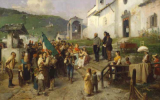Many Institutions, Few Artists: The business of Contemporary Art in Italy
by Walter SANTAGATA
As in all worlds of art and culture, even in contemporary art there are two conflicting policies at work: conservation and production of new works of art. Whereas conservation means to safeguard the historical heritage of a country, its most immediate expression being the “museum-ization ” of art, i.e. the entrusting of art to the sacredness of a museum, production means to create new works of art. Conservation is a backward- looking policy dealing with the preservation of the past; production is instead a forward-looking policy interested in the future and in the development of new works of art. Conservation relies on legal and institutional instruments, such as regulations and laws, whereas production is a policy consisting of many different steps: selection of artists, creation and production of works of art, distribution, modes of consumption.







